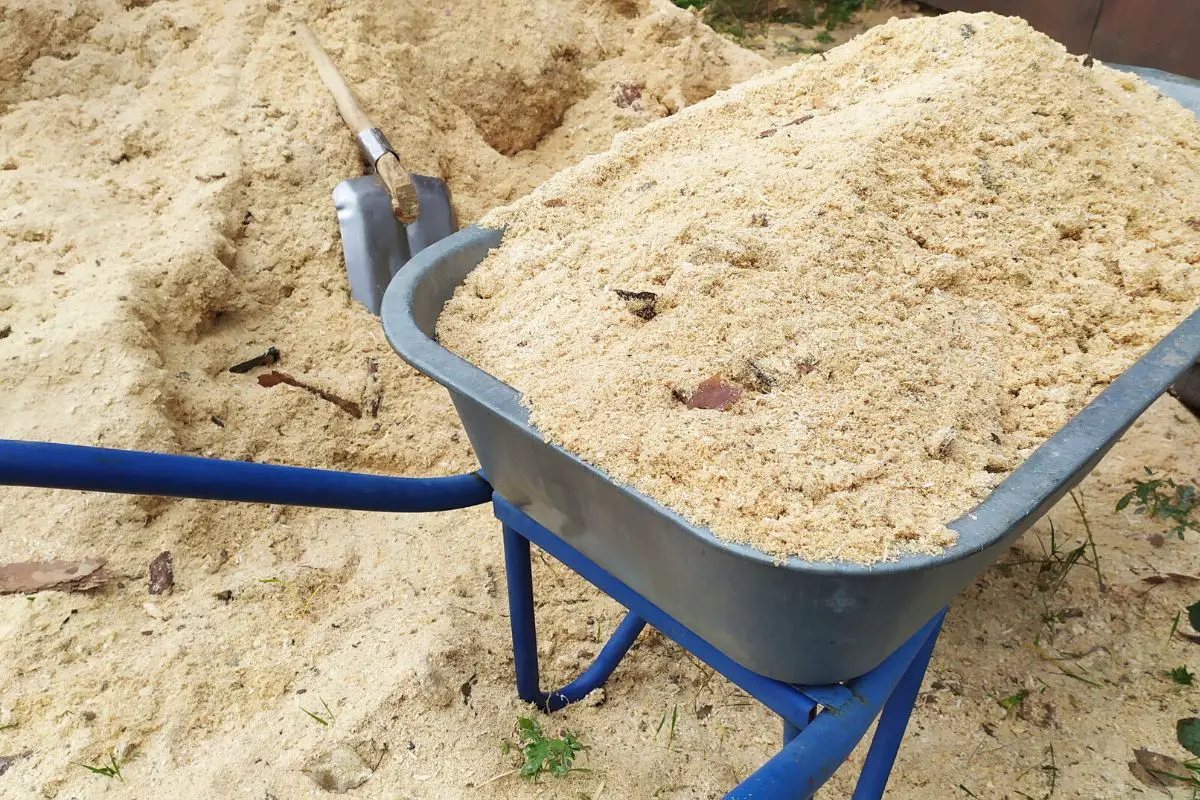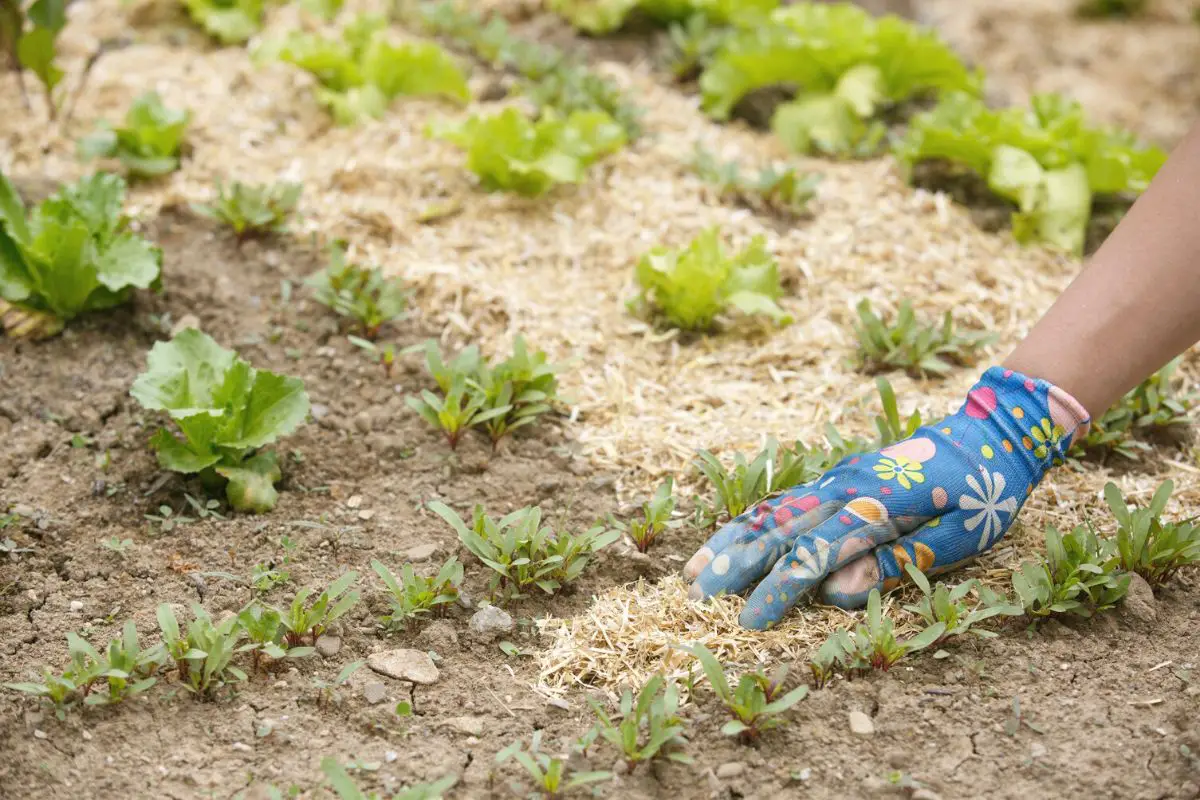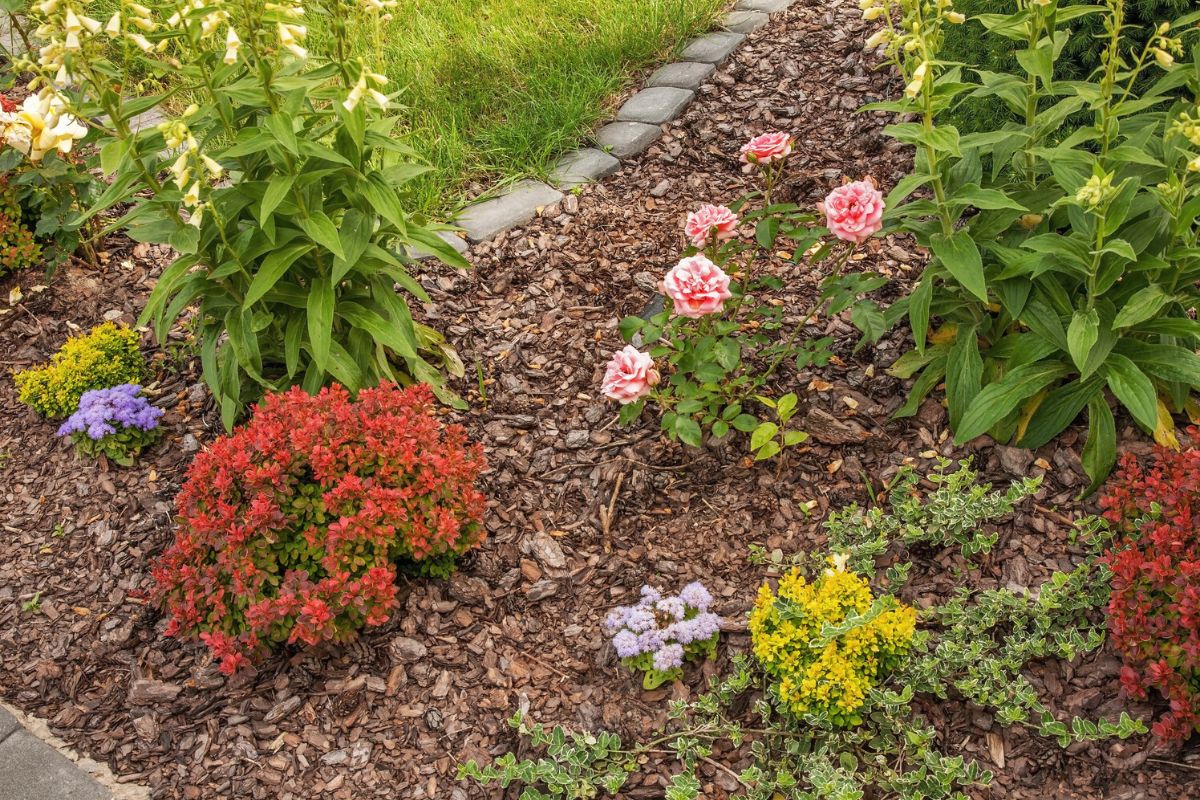Many people love growing strawberries because they are sweet, juicy, and a pretty sight in gardens. For excellent yields, farmers often use straw mulch around their strawberries, but slugs love them too. Luckily, there are plenty of organic ways to eliminate slugs from your garden.
Organic strategies, such as liquid coffee, garlic spray, and crushed eggshells, can kill slugs or deter them from attacking your strawberries. Diluting strong brewed coffee in water is the most effective method. It works well as a soil drench or foliar spray that eliminates slugs, especially if you use organic mulches like straw that are prone to attracting them.
Using organic methods in controlling pests is crucial to maintaining the health of your plants and the environment. In this article, I’ll explain how slugs and snails affect strawberries. I’ll also share traditional organic methods to control these pests and how to enhance straw mulch to make it helpful in preventing slugs.
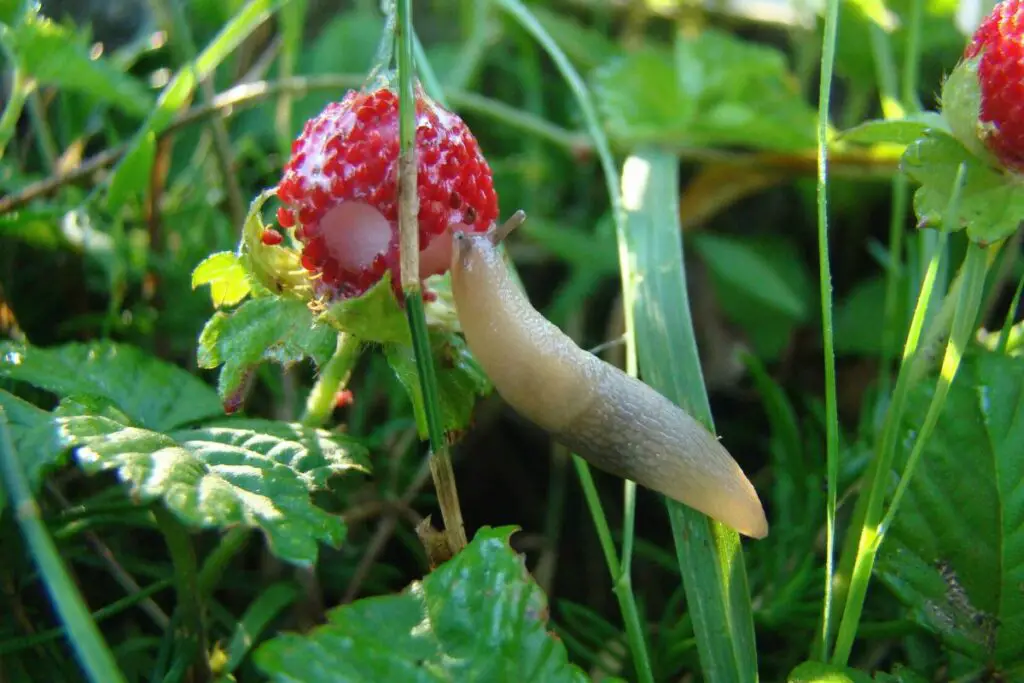
Identifying the Slug and Snail Problem
Slugs and snails are voracious feeders of plant leaves and fruits. As gastropods, their mouth has a radula comparable to a tongue with teeth-like structures called denticles that tear through the plant tissue and form irregular cuts.
Strawberries are especially susceptible to slug attacks because the foliage hangs close to the ground. The low-lying fruits are also easily accessible to these pests.
In addition, the common practice of mulching strawberries with straw makes it more attractive to slugs and snails. The mulch layer provides a safe and moist hiding spot for these crawlers.
Signs of Damage
Numerous pests can feed on strawberries, but you can confirm if the damage is caused by slugs or snails through the following signs:
- Fresh wounds from gastropod attacks appear irregularly shaped.
- Slugs usually leave behind a slimy, silvery trail on the leaves or the ground.
- You can catch slugs after dusk because they are nocturnal.
It can be tempting to eliminate these pests using commercial-grade synthetic pesticides after seeing the damage they cause to your precious strawberries. However, note that pesticides can remain in the soil and can sometimes cause health and environmental issues.
Even commercially available organic pesticides are not entirely safe because some are formulated or mixed with substances that can be toxic to the environment or the human body.
Strawberries are also eaten as a whole (with peel included), and washing isn’t often enough to remove pesticides that seep into the fruit’s flesh.
Therefore, it’s crucial to use organic methods to eliminate the slug or snail problem in your strawberry garden.
Traditional Organic Methods for Slug and Snail Control
There are plenty of tried and tested organic ways to protect plants from slugs and snails.
Below are some of the most effective and environmentally safe methods you can employ in your home garden:
Liquid Coffee and Grounds
Coffee is one of the most effective and economical organic methods to eliminate slugs from your home garden quickly. You can use it in liquid form as a soil drench or foliar spray or in solid form as a physical barrier.
Soil Drench
Mixing two cups (500 ml) of strong brewed coffee with one cup (250 ml) of water will make a potent soil drench that will kill the slugs hiding in the soil and prevent others from invading the space.
Using this method once every two weeks should be enough to deal with slug problems. You can pour the solution into the soil or over the mulch layer around your strawberries a day before the watering schedule or an expected rainfall.
Although liquid coffee can be acidic with a pH level of around 5.0, the effect is short-lived. Strawberries also thrive in slightly acidic soils with a pH ranging from 5.4 to 6.5. Therefore, liquid coffee won’t negatively affect your strawberry plants.
However, it’s best to use this method on established strawberry plants, as the chemicals in coffee might have inhibitory effects on seedlings.
Foliar Spray
If slugs are crawling up your strawberry plants, you can use liquid coffee as a foliar spray. Mix one cup (250 ml) of brewed coffee with nine cups (2.2 l) of water.
Spray the liquid on one leaf early in the morning. Wait 24 hours to check for any negative reaction, such as leaf spots or dryness. If there’s no adverse reaction, you can go ahead and use the spray on your plant.
I recommend spraying the solution on your strawberries at night because that’s when the slugs come out. In the morning, manually remove the dead slugs that fall off your plant to prevent other animals like flies, snakes, and raccoons from visiting your garden.
You can bury them in an isolated part of your garden to lure more slugs and make it easier to collect and eliminate them. Dead slugs will eventually decompose and enrich your garden soil.
Coarse Grounds
Coffee grounds are also a great way to reuse those spent coffee grounds from your daily morning brew. Slugs generally do not like the coarse texture of coffee grounds. Scattering some coffee grounds around your strawberry bushes will keep them away.
Choose the coarsest grounds you can find because finer grounds don’t have much effect on the snails. In addition, finer grounds can compact or form clumps when wet, making it unsafe in large amounts on your garden soil.
Note that coarse grounds are ineffective if there’s a mulch layer around your strawberry plants.
Crushed Eggshells
Crushed eggshells scattered around strawberry plants make it extremely difficult for slugs to approach. The sharp, ragged edges of the eggshells will pierce through their skin if they attempt to crawl over them. No amount of strawberries will be worth crossing with such an uncomfortable obstacle.
However, before spreading the eggshells around your plants, remember the following facts and tips:
- There’s no nutritional value in using eggshells as a protective barrier around your plant. The nutrients in eggshells typically come from the membrane and residues, and the coarse outer shell mainly consists of calcium carbonate.
- Remove the soft membrane and residues lining the insides of the shell. The egg residues might attract other pests, such as flies, into your garden.
- Crush the eggshells into small, sharp pieces the size of rock salt. Large pieces may be too smooth, making it easy for slugs to crawl over.
- Eggshells can take a very long time to decompose. If you’re worried about their negative effects on your garden aesthetics, opt for a different solution.
- Fluff up the eggshell barrier regularly to keep it effective. If the layer flattens, slugs can easily crawl or climb over them.
In my experience, If you have laid down organic mulches, eggshells are less effective in deterring snails, as they tend to mix with the mulching materials, especially when they get wet.
You can place the crushed eggshells around your strawberry plants in spring right after clearing the soil of your winter mulch. Create a barrier an inch (2.5 cm) wide and high, at least 2 inches (5 cm) away from the crown of your plant.
Garlic Spray
The allicin in garlic will kill or deter slugs. Fortunately, spraying garlic mixture on your strawberry plants won’t harm them.
Here’s how to make garlic spray for your strawberries:
- Place 1 head of garlic in a food processor. Blend until you achieve a smooth consistency.
- Add 2 cups (500 ml) of water. Pulse a few times until the elements are well-dispersed.
- Pour the mixture into a glass jar. Leave it covered in a dimly lit area overnight to let the garlic completely settle.
- Pour the mixture into a larger jar. Use a strainer to get rid of any solid particles.
- Add enough water until you have a 1-gallon (3.8 l) mixture.
- Transfer some of the mixture into a spray bottle. Pour only the amount you need because this mixture must be stored in the fridge when not in use.
- Spray liberally all over your strawberry bushes.
- Use the spray once a week, at most.
Garlic spray will also repel other pests such as aphids, mealybugs, and spider mites, making them an excellent organic pest control essential in your gardening arsenal.
You can spray the solution on the mulch layer. You can also lift some straw mulch off the ground before spraying the soil to catch slugs or snails hiding underneath it.
Exploring the Use of Straw Mulch
Straw is a popular mulch material for strawberries because it’s lightweight and breathable. It can also absorb the rain impact quite well, keeping the water from splashing back to the low-hanging fruits and foliage.
Based on the quality common to many organic slug deterrents listed above, many gardeners thought the pointy tips of straw mulch would be effective against slugs. Freshly applied straw might be effective to keep slugs off your strawberries.
However, that isn’t always the case. After about a week or two of rain or regular watering, the mulch layer flattens and loses the pointed tips. The added moisture helps slugs slither about more comfortably, straight toward your sweet strawberries.
Wet straw also tends to clump, making it a great hiding spot for slugs, especially in the daytime when the sun is too hot. Thus, moist straw mulch may attract slugs as an ideal place to hide from predators and the sun.
Nevertheless, don’t shy away from using straw mulch on your strawberries. Although it can attract a few slugs and snails, let’s not forget about its effectiveness as a mulch layer.
Strawberries will need plenty of water during the fruiting season and might even require daily watering sessions. The straw mulch layer will keep the soil moist to sustain your plant’s water needs.
In addition, strawberries like moderate temperatures ranging from 50-80 °F (10-27 °C). Straw mulch will help keep the soil temperatures within this range despite fluctuating environmental conditions.
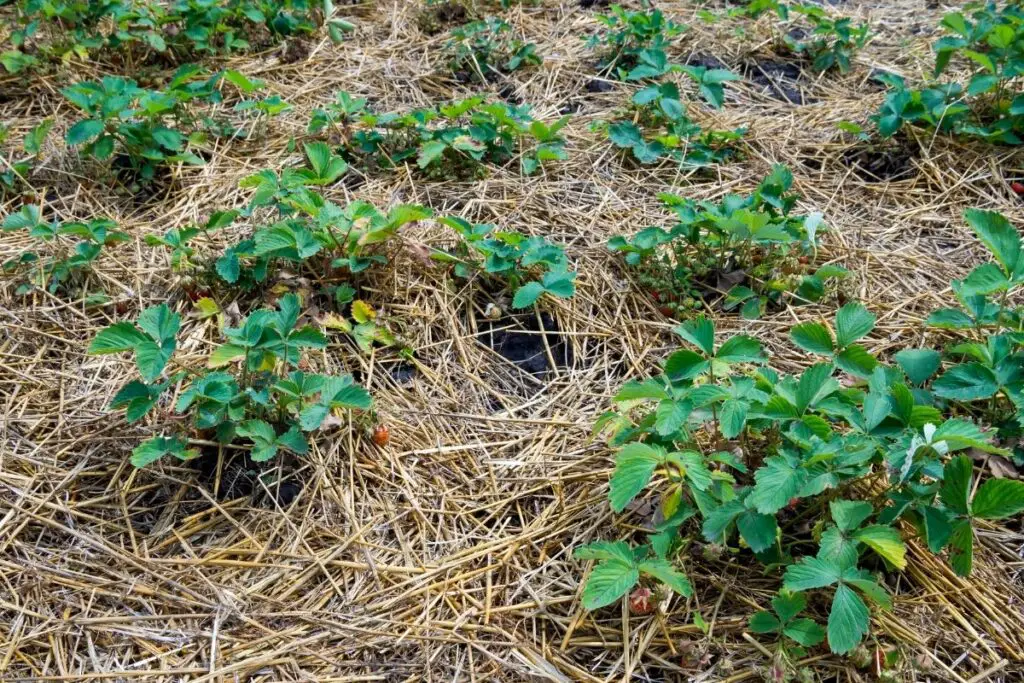
Combining Straw Mulch with Other Slug Deterrents
Overall, straw mulch (or other organic mulches) is an indispensable material for growing strawberries. The mulch layer aids in moisture retention and temperature regulation. It also protects against weeds and soil erosion from heavy rains.
To obtain these benefits and still prevent slugs, you can drench the straw mulch with a liquid coffee solution once every two weeks. This should eliminate the slugs hiding underneath the mulch layer.
Alternatively, you can spray the plant with a garlic spray once a week. The combination of straw mulch and organic sprays will effectively keep your plants thriving and safe from slugs or pest infestations in general.
DIY Barriers and Traps
In addition to traditional organic methods of controlling slugs, you can create barriers around potted strawberries or install traps in the soil surrounding your plant. These strategies are also proven effective against slugs when used correctly.
Follow these tips on how to install the DIY barriers and traps listed below:
Petroleum Jelly
The petroleum jelly method works only for potted strawberry plants. The jelly forms a slippery, gooey layer when slathered around the pots. It would be nearly impossible for slugs to scale the pots and get to the sweet strawberries.
You can also mix a little bit of salt with petroleum jelly. This mixture is a potent deterrent because salt is lethal to slugs.
Upon contact, salt dehydrates slugs, eventually killing them. In their futile attempt to get to the strawberries, slugs will unknowingly expose themselves to salt.
Copper Tape
Creating a copper tape barrier around your potted strawberry bushes is another great way to stop slugs from feasting on your crops. You can wrap it along the middle of the pots to keep the slimy crawlers from reaching the top.
The tapes send little electric shocks when slug slime touches them, effectively sending the slimy creatures slithering away. Copper tape isn’t harmful to the plants or the soil, making it a more environmentally friendly option.
Citrus Distractions
Slugs love citrus fruits like lemons, oranges, and grapefruits. Take their attention away from your strawberries by scattering citrus peels around your strawberry bushes or pots.
You can place them over the soil or on the mulch layer. These will be easier to get to than the strawberries, so slugs will undoubtedly choose these over your precious crops.
Pluck the slugs out of your garden or use garlic spray on them whenever you see them munching on the citrus peels.
Beer Traps
Slugs are also attracted to beer. It’s the yeast in beer that they love, and you can make use of this yeast appeal to your advantage. Fill bowls with beer and lay them out into shallow holes near your strawberry plants.
Approaching slugs eyeing your crops will be distracted by the scent and want to investigate. Slugs reaching in for a drink will fall into the beer-filled bowl, drown, and die. Replace the beer trap as soon as it is filled with slugs.
Diatomaceous Earth (DE) Barrier
DE is a powder with sharp particles made up of various marine organisms. It’s a potent irritant for slugs, sending them slithering away to safety upon contact.
Lay an inch-wide (2.5 cm) barrier of DE a few inches (5+ cm) away from your strawberry bushes. Remember to replace it after it rains because DE loses its potency when wet.
One downside of the DE barrier is that you cannot use it along with a mulch layer. The organic mulch will likely hold moisture, making the DE barrier ineffective.
Iron Phosphate
Another potential remedy against slugs infesting your strawberry garden is an iron-phosphate-based slug or snail bait. These baits come in granular form that you can broadcast on your strawberry garden.
As the snails or slugs crawl over and eat the granules, they will gradually suffer from intestinal damage that will kill them.
Here are the other advantages of using this method for slug or snail control:
- The granules don’t readily dissolve when wet, making them effective for quite some time.
- Iron and phosphate are natural soil minerals that won’t cause toxicity once the granules break down into the soil.
- They’re not toxic for earthworms and other beneficial insects.
- They won’t cause nutritional or toxicity issues with humans or pets upon accidental ingestion due to low concentrations.
The only possible downside of these iron phosphate granules is that when they break down and dry out, they can cause mild eye irritation or sneezing upon contact.
To prevent this, you can tuck the granules underneath the mulch layer of your strawberry garden. This will keep them moist and safe from the wind. They will also become more accessible to the target slugs and snails hiding underneath the mulch.
Monitoring and Continuous Management
Although the organic solutions discussed above generally help in controlling slugs, they’re not always 100% effective. It’s still important to closely monitor your strawberry plants regularly for potential health and pest problems.
Treating your garden of slugs is not a one-time or permanent solution. The rain can wash away spray treatments or flatten or erode the coarse barriers. Wind will also blow away dry eggshells, diatomaceous earth, or coffee grounds and leave your plant unprotected.
Moreover, slugs and snails, although slow, can travel from one garden to another, reproduce, and infest unprotected plants. Protecting only your strawberries will likely make your other plants susceptible to these pests.
To ensure your garden remains slug-free, keep the following garden care tips in mind:
- Inspect your plants weekly. This is an essential garden care routine that will help you catch and fix problems as soon as possible. Look for potential leaf or fruit damage, check the soil moisture, and turn the mulch to check for pests underneath.
- Fluff up the coarse barriers every week or so to bring out the sharp or ragged edges that make them effective against slugs.
- Reapply the barriers, such as petroleum jelly, coffee grounds, or diatomaceous earth, as needed.
- Replace the traps or baits as soon as they’re used up or damaged.
Like with any pest problems you encounter as a gardener, slug control is a year-long commitment because these slimy pests are active all year round. However, they’re most active in spring when the plants are still young.
Elimination of Shelter
It’s not entirely necessary, but it’s common for gardeners to clear the straw mulch in early or mid-spring once the temperatures are steadily above 50 °F (10 °C).
Removing their mulch shelter can help in case of a severe slug infestation. Still, it won’t completely keep slugs and snails off your strawberries. That’s why it’s still necessary to have some slug deterrents in place.
If you habitually clear the mulch layer after the threats of the last frost have passed, you can place DIY barriers like crushed eggshells, diatomaceous earth, and coarse coffee grounds around your strawberry plants.
In my case, I clear the mulch just enough to expose the new strawberry leaves and keep a safe distance (1-2 inches or 2.5-5 cm) between the mulch and the plant stem. The mulch layer will still be beneficial for weed suppression and rain absorption.
So, if you tend to keep and top up the mulch layer for continued weed and rain protection in spring, you can continue using garlic spray to keep slugs at bay. I hold back on the liquid coffee treatment for about 3-4 weeks or until the plants are at least 4 inches (10 cm) tall to prevent any growth inhibitory effect.
What I’ve Learned: Liquid Coffee Works Best
I usually use straw or sawdust around my strawberry plants, exposing them to potential slug infestations. I had seasons, especially after rainy and wet weeks, in which I lost many strawberries (and plants) to slugs eating their way through my produce.
This is why I tested all potential organic deterrents mentioned before.
Among the organic methods listed above, I’ve found much success in using the coffee treatment. As a coffee lover, I have a surplus of spent coffee grounds that I use in my garden for various purposes.
I realized long ago that coffee grounds don’t acidify the soil, and liquid coffee has only short-term effects on soil acidity. The nutrients in coffee are also minimal and more useful in feeding soil microbes instead of plants.
Understanding the qualities of coffee will help you use it as a potent solution against pests like slugs and snails.
Fellow gardeners shared doubts about the effectiveness of eggshells, diatomaceous earth, and coffee grounds as barriers. However, note that the success of these materials largely depends on how well you prepare and maintain them.
Larger eggshells and finer coffee grounds will make it easier for slugs to crawl over. Similarly, diatomaceous earth will lose its potency when wet. More importantly, these materials don’t work well together with mulch.
After years of experimenting, I found a combination that works well for my strawberry garden. Laying straw mulch around my strawberries improved the quality and quantity of the produce, whereas using the liquid coffee soil drench protected them from slugs.
The key is to monitor and continuously manage your chosen slug control methods. You can also switch to another method that’s readily available for you or use several strategies simultaneously until you find one that works best in your garden.
Other Organic Mulches for Strawberries
Straw mulch isn’t the only suitable mulch for strawberries. Pine needles and grass clippings will work similarly to straw mulch. However, they’ll also require slug control methods because they don’t have any pest-deterrent properties.
As perennials, strawberries also do well with wood chip and bark mulch. Coarse bark or wood chips scattered around strawberry bushes will be tremendous obstacles for slugs due to their ragged edges.
However, rain and excess moisture can turn bark and wood chip mulch into great hiding places for slugs. Wet bark and wood chips will entice slugs to hang out around your strawberry bushes. It would only be a matter of time before these crawlers figure out how to get to the delectable strawberries.
Fluff up the bark or wood chip mulch layer every two weeks to improve air and moisture penetration in the soil and disturb any pests hiding underneath it. This can also bring out the ragged edges of the bark and wood that will deter slugs from attacking your plant.
For extra protection, you can use liquid coffee or garlic spray solutions along with your chosen mulch to eliminate or prevent slugs.
Final Thoughts
Slug control can be achieved using proactive approaches like a liquid coffee soil drench or foliar sprays containing coffee or garlic. If you’re more into passive control, you can use eggshell barriers, beer traps, or citrus peel lures.
Regardless of the method you choose, its effectiveness largely depends on how often you check your plants and maintain the treatment, trap, or barriers.
Of course, what works best for one gardener might not always work well for everyone due to differences in environments and care routines. Explore the organic solutions discussed in the article, and let us know which ones work best!

